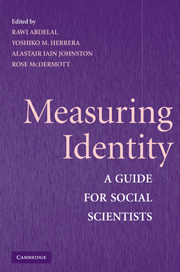Book contents
- Frontmatter
- Contents
- Contributors
- Introduction
- I DEFINITION, CONCEPTUALIZATION, AND MEASUREMENT ALTERNATIVES
- II SURVEY METHODS
- III CONTENT ANALYSIS AND COGNITIVE MAPPING
- IV DISCOURSE ANALYSIS AND ETHNOGRAPHY
- 10 Identity Relations and the Sino-Soviet Split
- 11 Techniques for Measuring Identity in Ethnographic Research
- V EXPERIMENTS
- Bibliography
- Index
10 - Identity Relations and the Sino-Soviet Split
Published online by Cambridge University Press: 05 June 2012
- Frontmatter
- Contents
- Contributors
- Introduction
- I DEFINITION, CONCEPTUALIZATION, AND MEASUREMENT ALTERNATIVES
- II SURVEY METHODS
- III CONTENT ANALYSIS AND COGNITIVE MAPPING
- IV DISCOURSE ANALYSIS AND ETHNOGRAPHY
- 10 Identity Relations and the Sino-Soviet Split
- 11 Techniques for Measuring Identity in Ethnographic Research
- V EXPERIMENTS
- Bibliography
- Index
Summary
Theory should determine method. How one theorizes about some outcome should drive which methods one chooses to assess the relative validity of competing claims about that outcome. In this chapter, how I theorize identity drives my methodological choice of discourse analysis. Had I chosen some variable other than identity, say objective military power, or had I chosen to theorize identity differently, say as the subjective perceptions of decision makers, then the method chosen would have been different. Because I theorize identity as an intersubjective social structure, the method I choose must somehow recover this intersubjective reality as experienced by its subjects. Intersubjectivity is the reality generated within a community, society, or group, of shared understandings of the world out there. It cannot be reduced to either objective reality – that is, the reality that is out there independent of our perceptions of it, or subjective reality, the reality each one of us perceives as individuals. If it were the latter, then one need only look into the heads of individual decision makers to find out what they believed. If it were the former, one need only catalog the objective indicators presumed to be causal for any particular theory.
In what follows, I present a constructivist theory of identity that is at once social, structural, and cognitive. I explore three logics of social order – consequentialism, appropriateness, and habit – and relate them to the theory of identity I apply to the study of a state's foreign policy choices.
- Type
- Chapter
- Information
- Measuring IdentityA Guide for Social Scientists, pp. 279 - 315Publisher: Cambridge University PressPrint publication year: 2009
- 24
- Cited by

